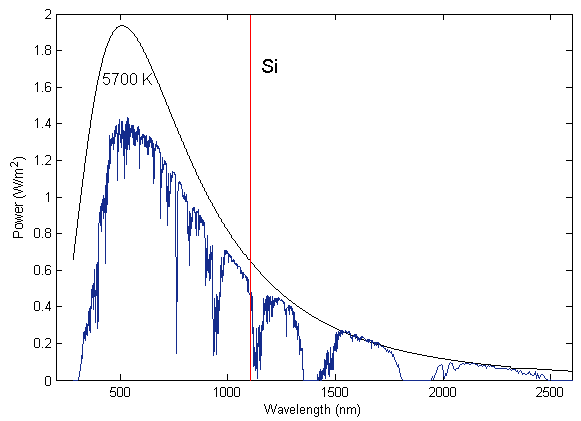A month ago a report appeared in Science magazine on a new prototype solar cell that could produce more than one electron, a packet of electrical energy, from one photon, a packet of light energy. This trick isn't new, I discussed a bunch of such concepts years ago in a post on
quantum photovoltaics. What's new is that Samber et al. report in "
Multiple Exciton Collection in a Sensitized Photovoltaic System," have achieved high efficiency in this process.
The typical goal for these sort of 'quantum' solar projects is to better match the wavelengths of light the photovoltaic system can absorb to that of the spectrum of light that is produced by the sun (and filtered by the atmosphere). The theoretical limit for Silicon alone in a photovoltaic system is 33.7 %, which is known as the
Shockley-Quiesser limit. Of course, most commercial PV systems are only around 12 % efficient or less, so there is still considerable room for growth. An example of such a spectrum-matched system is
Spectrolab's space photovoltaics, which are actually stacks of multiple photovoltaic systems all operating at different wavelengths, and achieve roughly 30 % efficiency in a commercial product.
 |
| Figure 1: The air-mass 1.5 standard spectra (indigo line), which is an estimate for the spectra that arrives at the Earth's surface after passing through the atmosphere. The red line is the band-gap for Silicon; for longer wavelengths (red-er) Si cannot absorb the photon. For shorter (blue-er) wavelengths the extra energy is lost. |
If you could get one electron out from a infrared photon and two from a blue photon, then the energy gained is fairly significant. This result has been reported on before, but in this paper, for the first time, the overall system produced more electrons out than photons in, as observed to just isolated nanoparticles. In photovoltaic parlance, the number of electrons produced per photon is known as the quantum yield, but this doesn't describe how many electrons actually escape and result in electrical
current. That quantity has the wordy name, absorbed photon-to-current efficiency.
 |
| Figure 2: Absorbed photon-to-current efficiency (APCE) as a function of wavelength for the described cells. The x-axis is in electron volts, to convert to wavelength, divide 1240 nm by the photon energy [Fig 4. from Sambur et al., 2010]. |
Overall,this would be a really interesting paper except for one obvious drawback: the active layer of quantum dots is really really thin. There's only a single layer of quantum dots and given an average diameter of 10 nm, that's not very think for visibile light. Compare that to a standard Silicon cell being hundreds of microns, or a thin-film cell at 10 μm which is still a thousand times thicker. In fact it's so thin that they absorb only 1-2 % of the incoming light.
Since the problem with quantum dot strategies is always getting the electrons out, and not absorbing the light, I'm not sure that this work will have a great impact when scaled up. At the very least, however, it does show that it's possible to build a quantum dot solar cell that works as advertised, producing more than one electron per photon, and doing that quite well.


No comments:
Post a Comment